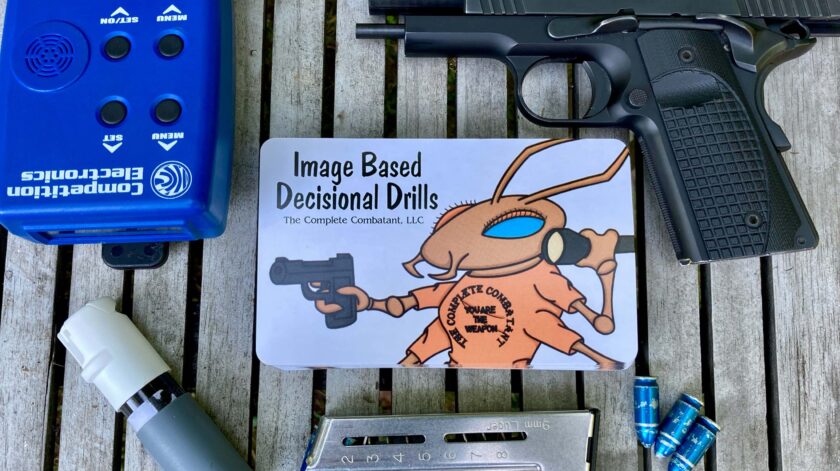Uncertainty is very difficult to create in firearms practice sessions. Ninety-nine times out of a hundred when you draw your pistol you are about to execute a predetermined course of action. You know that you’re going to fire and exactly how many rounds you are going to fire. And you know this long before you draw. It can be difficult to build decision-making into the process of firearms training, and especially solo practice sessions. I recently discovered a product called Image Based Decisional Drills that is designed to help with that.
Full Disclosure: I was provided a complete set of Image Based Decisional Drills by The Complete Combatant. I have no financial relationship with The Complete Combatant and receive no kick-backs or affiliate sales commissions from the sales of this product. This article does contain affiliate links to other products, however.
Image Based Decisional Drills
Image Based Decisional Drills are a product of Brian and Shelley Hill at The Complete Combatant. There are already several reviews of this product online, but considering my extensive dry practice history I thought I might be able to offer a slightly different take – one focusing on dry practice.
The core of the Image Based Decisional Drills tool is a deck of cards, each bearing an image. Flipping the card over to reveal the image, the shooter must process the information presented in the scene, make a decision, and act. Some of the cards illustrate deadly-force threats…but many do not. The cards are designed to allow users to apply tools from the full spectrum of force including walking away, issuing verbal commands, using a flashlight and/or pepper spray, using deadly force, calling 911, or administering first aid. But I’m probably getting a little ahead of myself.
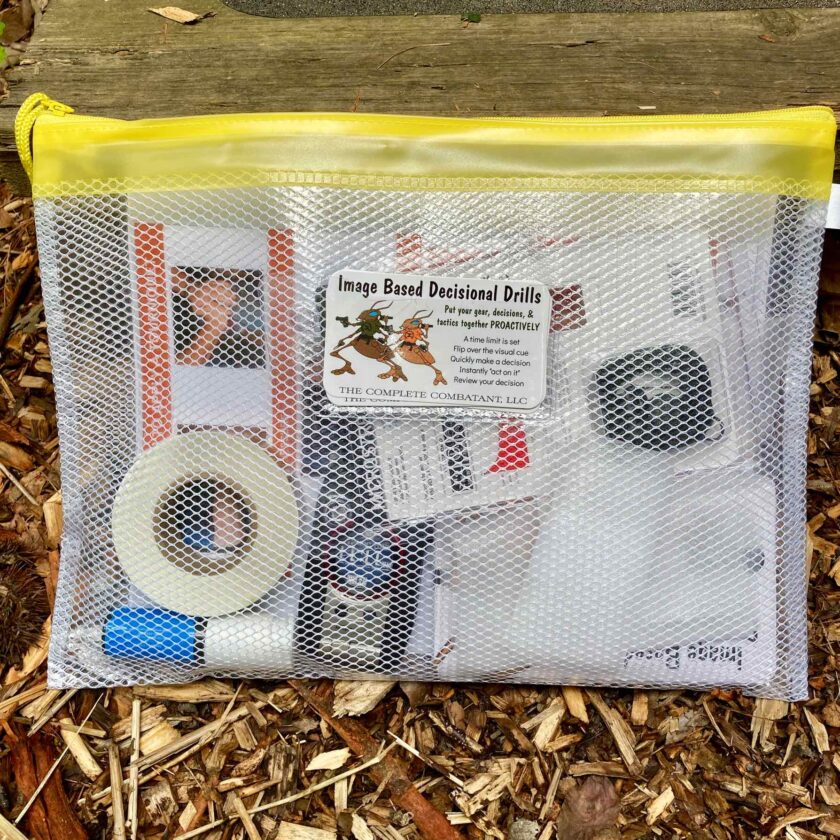
The full IBDD kit contains almost everything you need to get to work. It is contained in a water-resistant, zippered bag. It contains an instruction booklet, a “cheat” sheet, 21 image-based “decision” cards, a Streamlight Microstream flashlight, an inert POM pepper spray, a non-working cell phone, an instructional guide to applying a tourniquet, and roll of target pasters.
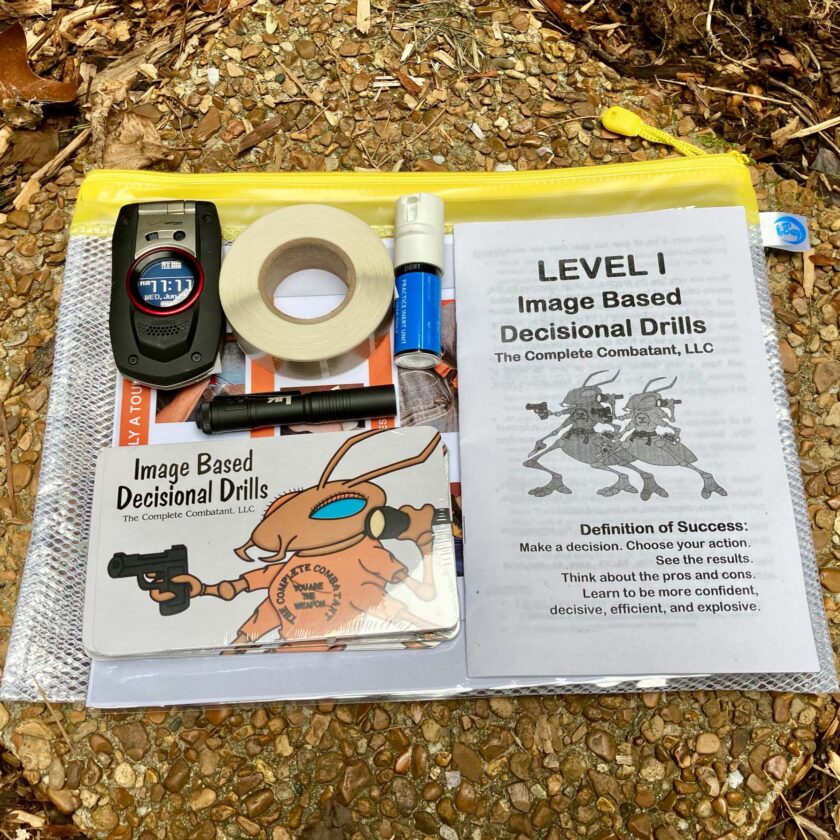
This gives you (almost) everything you need to exercise the full spectrum of defensive skills. What do you need to bring? You need to bring your handgun and holster, targets, a tourniquet, and a shot timer – all things you should already have. I have just a few more things to say about some of the items that did come with the kit.
I really appreciate that the kit comes with an inert pepper spray unit. Checking the Complete Combatant’s website I noticed that a recently past pepper spray instructor class with Chuck Haggard was sold out. That is really exciting and indicates that people are seeing the value of pepper spray. Still, I get a lot (a LOT) of yawns when I recommend having an inert pepper spray canister, practicing with pepper spray, or practicing transitioning from pepper spray to deadly force and vise-versa. It’s hard to get people to want to buy an inert container, so I think putting one in their hands is a fantastic idea. I found that removing the sticker from the inert unit allowed it to fit in the POM cover from a live can of POM spray, allowing me to carry it in the same fashion during practice sessions.
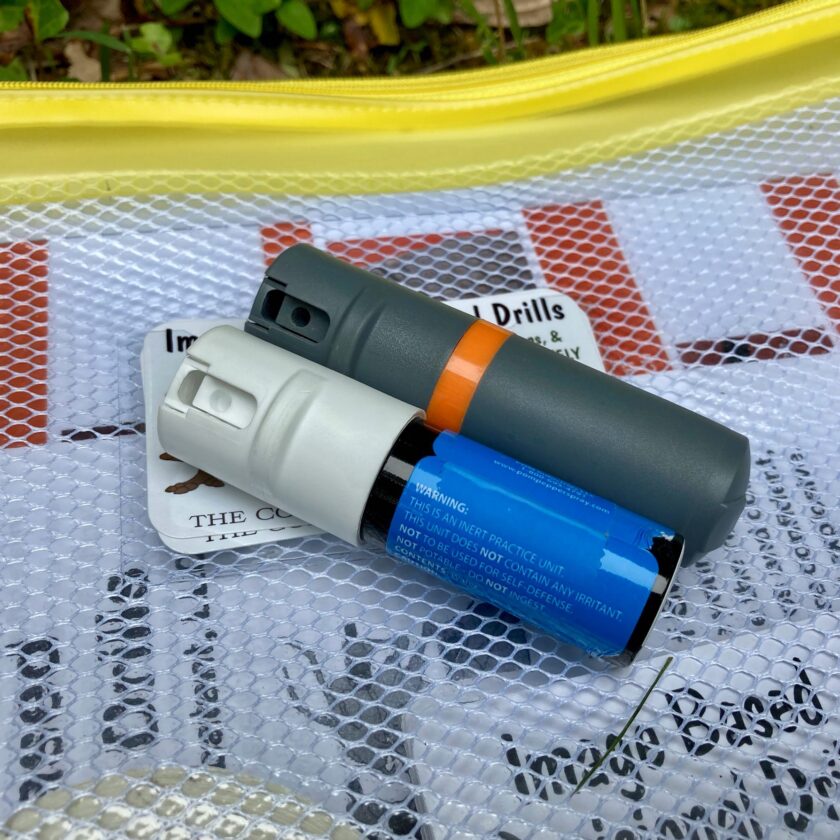
The flashlight contained in the kit is the Streamlight Microstream I reviewed on Monday. This isn’t a bad little light at all. In fact, it’s probably one of the best AAA-powered lights available. If you don’t already own a flashlight this wouldn’t be a bad one to carry.
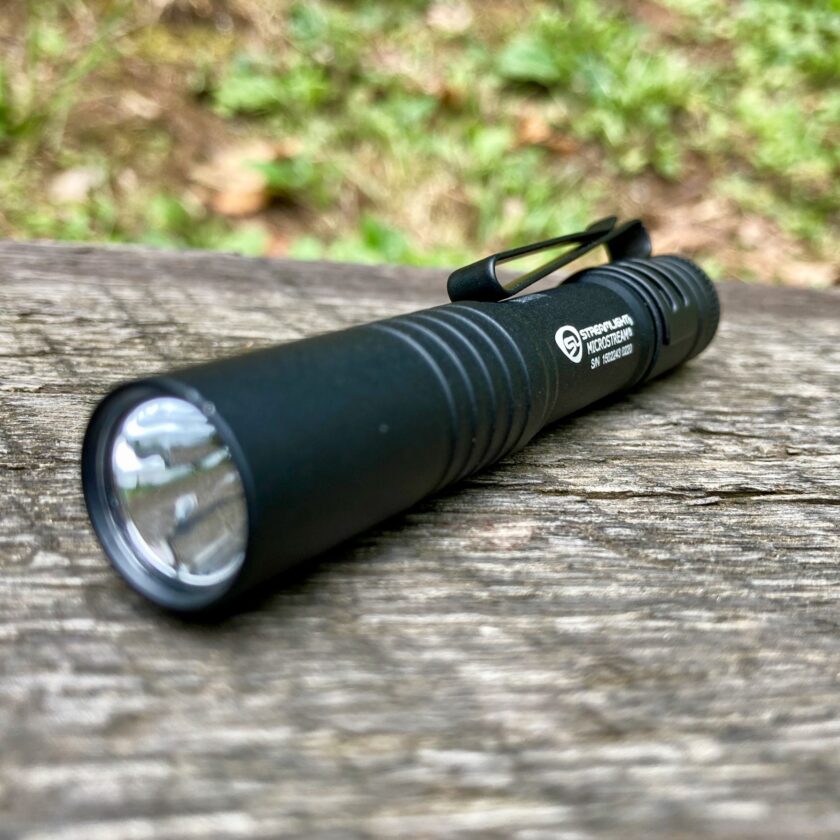
I’ll be honest – I didn’t use the phone at all. I spent the first two weeks of dry practice this month practicing calling 9-1-1 in the aftermath of a shooting (coincidentally this kit showed up on the first day of the third week of the month – perfect timing). I found that I was able to do this with my iPhone with no real trouble. Since most people carry smart phones I see maybe limited value in the inert flip-phone, though it may be a great option for some.
Using the IBDD Kit
I received the Image Based Decisional Drills kit less than two weeks ago but have already integrated it into my dry practice routine. I have used it on the live range, too, but for me this will probably make a much bigger impact on my dry practice sessions.
Shelley sent me several decks of cards, including the “Mingle”, Brian Hill, and “situational” decks. I used my normal dry practice location and laid out the cards and cheat sheet. I didn’t use the cheat sheet for the first session and regretted it because I left a few of my options (like walking away) on the table. I swapped out my live POM pepper spray for the inert can, and loaded my gun with snap caps. Everything else (my phone, my flashlight) remained the same.
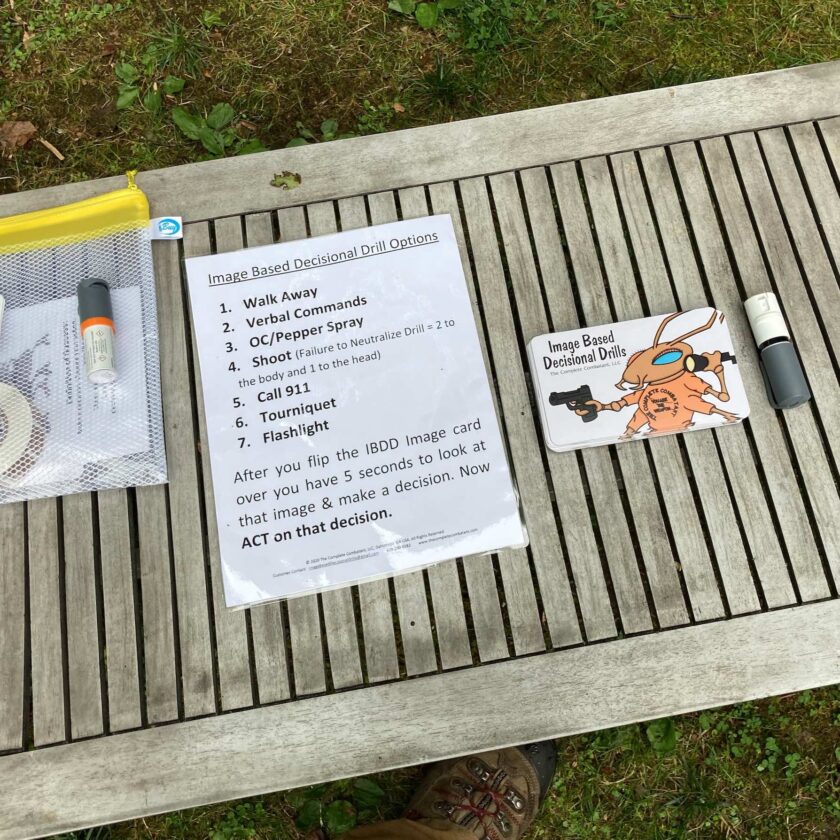
After setting everything up I got into it. The instructions recommend setting a five-second par. On the start buzzer flip a card, and take up to five seconds to make a decision and execute. On the first day I found this to be an extremely generous amount of time and decreased it to three seconds. I would stand, facing the target, with a card held at arm’s length. On the buzzer I would flip it, make my decision, and execute an appropriate technique from the spectrum of force.
I’m not going to reveal any of the cards here but some of them are very thought provoking. Some were an immediate, “threat! Draw!” while others were, “hmm, that’s clearly a medical emergency but I want to know a little bit more before I walk into this scene.” Some of these cards elicited a “I’m not going into that at all, I’m just going to call the cops and not get involved.” With a few cards I’m still not 100% what I would do with the information given.
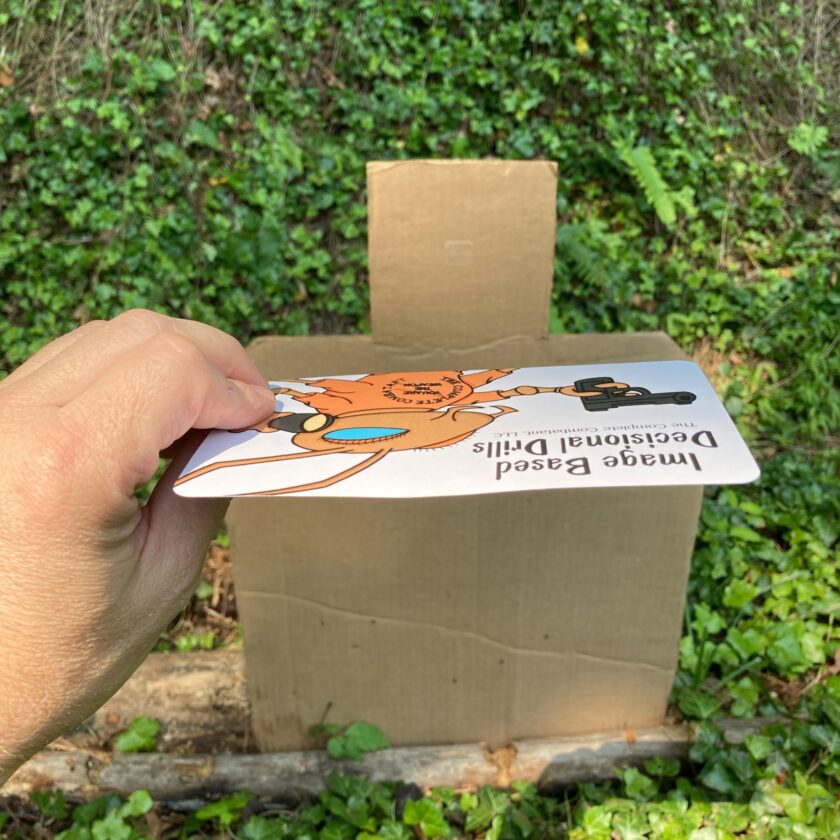
Which is kind of the point. Even doing “shoot/no shoot” drills leaves a massive gap. Sometimes a “shoot” can be downgraded to a “no shoot” with early application of appropriate force, like pepper spray. Sometimes verbal commands or just walking the fuck away are inherently viable options, but I bet you never practice those at the range. I don’t think I’ve ever gone to the range with the intent of practicing walking away. I go to the range to shoot and I’m pretty sure you do, too.
A Few More Thoughts
Overall I am very impressed with Image Based Decisional Drills. I strongly recommend you use a timer with these. If you don’t own a shot timer it’s maybe the best $125 you’ll ever put toward training. It will do much, much more for you than optimizing your use of Image Based Decisional Drills, and it will certain do that. I like the Competition Electronics Pocket Pro II and would recommend it in confidence. It is the only one I own, however, and there are other good ones available. Just get something and start using it in practice.
Second, the ability to purchase card “expansion” packs is pretty awesome. If you only have the original 21 cards, you get to know the cards pretty quickly. Your brain can pre-program a response to seeing a card, short-cutting the “decisional” aspect of this tool. Adding new cards into the mix is a fantastic way to mitigate this and I will definitely be purchasing some expansion packs. The Complete Combatant has worked with some well known trainers like John Murphy, William Aprill, Sherman House, and John Correia who have contributed their own expansion packs.
I really, really appreciated the additional decks. The cards in the “Situational” deck simply describe a situation, such as “LOW LIGHT.” They are intended to be drawn separately from the regular deck and provide some additional parameters on successive cards. Upon drawing the “LOW LIGHT” card for instance, you are to behave as if you are in low light settings. I won’t give away all of the cards but one involved sitting in a vehicle, so I conducted an entire dry practice session from the driver’s seat of my car – not something I or most of you probably do regularly.
Parting Shot
Image Based Decisional Drills will absolutely become a regular part of my dry practice routine. They add something other than raw, technical skill. Technical skill is important but it leaves a lot to be desired and Image Based Decisional Drills fill a lot of that gap. I will be purchasing expansion packs and using them. This will become a regular part of my dry practice routine, though I will “ration” it to keep the cards somewhat fresh.
The full kit reviewed here costs $99 from the Complete Combatant website. A “No Kit” option is also offered that omits the flashlight, pepper spray, and phone. If I’m being honest this is probably what I would recommend for most of my audience, on the assumption that most of you already possess a preferred flashlight and inert pepper spray. I absolutely believe this kit is worth the money, and as I said, will be purchasing expansion packs to increase the longevity and novelty. If you’re serious about building something other than technical skill into your routine I highly recommend Image Based Decisional Drills.
